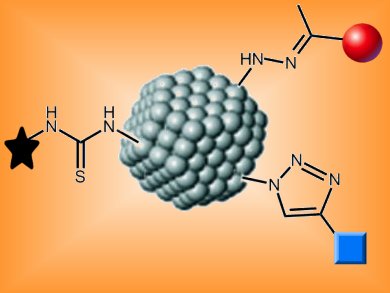Nanocarriers that combine multiple properties in an all-in-one system hold great promise for drug delivery. The absence of technology to assemble such highly functionalized devices has hindered progress in nanomedicine so far.
Geert-Jan Boons and colleagues, University of Georgia, USA, report a versatile approach for surface modification of nanoparticles (NPs) by using three bioorthogonal coupling reactions. NPs were prepared that have a gold core modified with a monolayer of poly(ethylene oxide)-β-poly(ε-caprolactone) (PEO-b-PCL) block polymers. The polymers were modified at the PEO terminus with acylhydrazides, amines, and azides. This allowed the introduction of functional modules through coupling with ketones, isocyanates, or active esters and alkynes, respectively.
The strategy is highly modular and permits many different combinations of surface modules as demonstrated by the team’s proof of principle NP which combined peptides for improving cellular uptake and for lysosomal escape, and a fluorescent label for quantification.
- Multifunctional Surface Modification of Gold-Stabilized Nanoparticles by Bioorthogonal Reactions
X. Li, J. Guo, J. Asong, M. A. Wolfert, G.-J. Boons,
J. Amer. Chem. Soc. 2011.
DOI: 10.1021/ja2012164



